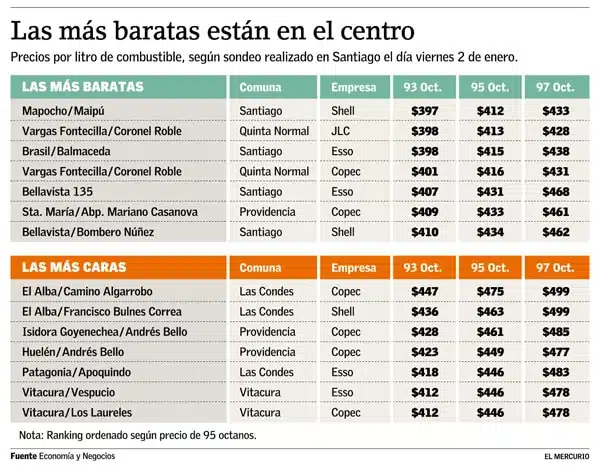Actualization on fuel prices in Chile: new gasoline costs effective from Thursday, February 13

The recent update on fuel prices in Chile has become a topic of great interest for citizens, especially with the announcement of new costs for gasoline that will take effect starting Thursday, February 13, 2025. In this context, it is highlighted that while gasoline and other fuels remain stable, kerosene will experience a significant adjustment. This change reflects the fluctuations of the international market and underscores the importance of being informed about changes in fuel prices, given their impact on the daily economy of Chilean consumers.
Recently, the National Oil Company (ENAP) has revealed the new prices that will govern the Chilean market starting Thursday, February 13, 2025. Although the 93 and 97 octane gasolines, diesel, and liquefied petroleum gas (LPG) will remain unchanged, a notable decrease in the price of kerosene is expected, which will have direct consequences for consumers.
Details on price variation
According to ENAP’s weekly report, the prices for the week are set as follows:
- 93 octane gasoline: No changes.
- 97 octane gasoline: No changes.
- Kerosene: Decrease of $13.7 per liter.
- Diesel: No changes.
- LPG: No changes.
The detailed review by ENAP allows consumers to anticipate and prepare for changes that directly impact their economy. It is important to note that this decrease in the price of kerosene responds to the fluctuations of the international market, as this type of fuel is not regulated under the Fuel Price Stabilization Mechanism (MEPCO).
Factors influencing fuel prices
Fuel costs in Chile are determined by a series of complex factors. The most relevant include:
- International oil price: Largely depends on crude benchmarks in the Gulf Coast of the United States.
- Exchange rate: The relationship between the dollar and the Chilean peso affects import prices.
- Specific taxes: Elements such as the Specific Tax on Liquid Fuels (IECL) are significant in the final cost.
- Stabilization mechanisms: Although MEPCO exists, it does not apply to all types of fuel such as kerosene, leaving these prices more exposed to sharp changes.
Practical tips for consumers
In light of this reality of fluctuating prices, strategies can be adopted to optimize fuel use:
- Compare prices: Use platforms like “Bencina en Línea” to find the most competitive stations.
- Vehicle maintenance: Regular maintenance can significantly improve fuel efficiency.
- Efficient driving: Maintaining a steady speed and avoiding harsh accelerations reduces fuel consumption.
- Explore alternative transportation options: Using public transport or biking can be an effective solution to save money.
Next price update
The next ENAP price report is expected to be published the following week, taking effect on Thursday, February 20, 2025. It is essential for consumers to stay informed to better manage their fuel budgets and adapt to market conditions.
Implications for domestic economy
Any alteration in gasoline costs has an impact on the family budget. The decrease in the price of kerosene, for example, will relieve the economic burden of many households that depend on it for heating and cooking. This type of adjustment can also influence the prices of other goods and services, as transportation is a fundamental component in the supply chain.
In summary, the landscape of fuel prices in Chile remains active and requires consumers to maintain a constant level of attention to fluctuations. Staying informed about changes and adapting consumption habits are key to mitigating the impact on family finances.
Update on fuel prices in Chile
The National Oil Company (ENAP) recently communicated that starting Thursday, February 13, 2025, the cost of various fuels in Chile will show significant changes. While 93 and 97 octane gasolines, diesel, and liquefied petroleum gas (LPG) will maintain their prices, kerosene will experience a notable decrease of $13.7 per liter. This movement is motivated by the fluctuations of the international market, once again showing the vulnerability of certain fuels to global changes.
The importance of this report lies in how fuel prices impact the economy of Chilean households. Often, the cost of kerosene is crucial for consumers who depend on this fuel for heating or cooking, making any variation in its price directly affect the family budget. Despite the reductions in kerosene, the other costs that remain unchanged should not be overlooked, as they also influence the country’s overall economy.
It is essential to remember that while ENAP provides these estimates, it is the fuel distributors who apply the final prices at service stations. This means that the prices seen at the pumps can differ due to various operational and commercial factors. Additionally, there are several elements that affect fuel prices, such as the exchange rate, specific taxes, and stabilization mechanisms, which, although helping to maintain a certain stability, do not apply to all fuels.
Finally, with the constant increase in energy prices, consumers must stay alert to variations and adopt practical strategies to optimize their fuel expenditure, thus ensuring a lesser impact on their personal finances.





